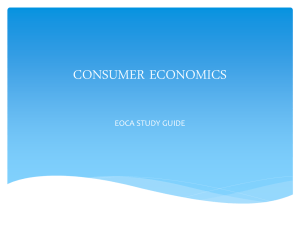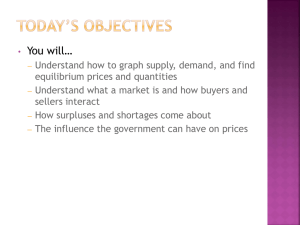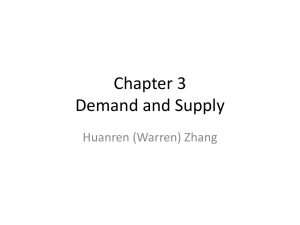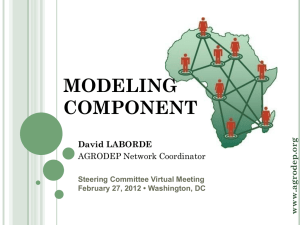Document
advertisement
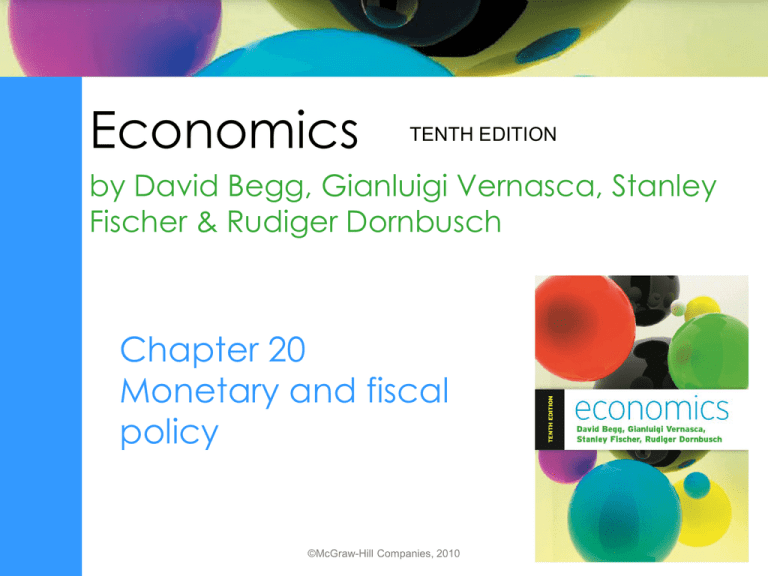
Economics TENTH EDITION by David Begg, Gianluigi Vernasca, Stanley Fischer & Rudiger Dornbusch Chapter 20 Monetary and fiscal policy ©McGraw-Hill Companies, 2010 Monetary policies • A given monetary policy has two aspects. • To what variable does it refer? – the interest rate or the money supply? – For the reasons given in the previous two chapters, we prefer to focus on the interest rate. • A particular relationship defining how the interest rate is chosen. – This may reflect discretionary choices of the central bank – or a commitment to a particular rule. ©McGraw-Hill Companies, 2010 Monetary policies (2) • In the heyday of monetarism, central banks used to adjust interest rates to stop the money supply deviating from a given target path of monetary growth. • Most central banks have abandoned this policy, preferring to target the inflation rate itself. ©McGraw-Hill Companies, 2010 The IS Schedule: Goods market equilibrium • The goods market is in equilibrium when aggregate demand and actual income are equal. • The IS schedule shows the different combinations of income and interest rates at which the goods market is in equilibrium. ©McGraw-Hill Companies, 2010 The IS schedule 45o line AD1 AD0 At a relatively high interest rate r0, consumption and investment are relatively low – so AD is also low. Equilibrium is at Y0. r Y0 Y1 Income r0 At a lower interest rate r1 consumption, investment and AD are higher. Equilibrium is at Y1. r1 IS Y0 Y1 Income The IS schedule shows all the combinations of real incomes and interest rates at which the goods market is in equilibrium. ©McGraw-Hill Companies, 2010 Shifts in the IS schedule • Changes in aggregate demand shift the IS schedule. For a given interest rate, more optimism about future profits raises investment demand. • Higher expected future incomes raise consumption demand. • Higher government spending adds directly to aggregate demand. • Any of these, by raising aggregate demand at a given interest rate, raise equilibrium output at any interest rate, • And lead to an upward shift in the IS schedule. ©McGraw-Hill Companies, 2010 The slope of the IS schedule • The IS schedule slopes down. Lower interest rates boost aggregate demand and output. • The slope of the IS schedule reflects the sensitivity of aggregate demand to interest rates. • If demand is sensitive to interest rates, the IS schedule is flat. • Conversely, if output demand is insensitive to interest rates, the IS schedule is steep. ©McGraw-Hill Companies, 2010 The LM schedule: Money market equilibrium • The money market is in equilibrium when money demand equals money supply. • The LM schedule shows the different combinations of income and interest rates at which the money market is in equilibrium. ©McGraw-Hill Companies, 2010 The LM schedule r r r1 LM r1 r0 LL1 r0 LL0 L0 Real money balances Y0 Y1 Income At income Y0, money demand is at LL0 and equilibrium in the money market requires an interest rate of r0. At Y1, money demand is at LL1,and equilibrium is at r1. The LM schedule traces out the combinations of real income and interest rate in which the money market is in equilibrium. ©McGraw-Hill Companies, 2010 The slope of the schedule • The LM schedule slopes up. • Higher output induces a higher interest rate to keep money demand in line with money supply. • The more sensitive is money demand to income and output, the more the interest rate must change to maintain money market equilibrium, and the steeper is the LM schedule. • Similarly, if money demand is not responsive to interest rates, it takes a big change in interest rates to offset output effects on money demand, and the LM schedule is steep. ©McGraw-Hill Companies, 2010 Shifts in the LM schedule • Shifts in the schedule reflect a change in monetary policy. • A rise in the target money supply means that money demand must also be increased to maintain money market equilibrium. • This implies a rightward shift in the LM schedule. • Output is higher, or interest rates lower, raising money demand in line with the rise in real money supply. ©McGraw-Hill Companies, 2010 Equilibrium in goods & money markets r LM Bringing together the IS schedule (showing goods market equilibrium) and the LM schedule (showing money market equilibrium) r* IS Y* Income ©McGraw-Hill Companies, 2010 We can identify the unique combination of real income and interest rate (r*, Y*) which ensures overall equilibrium. Fiscal policy in the IS-LM model Y0, r0 represents the initial equilibrium. r LM r1 r0 IS1 IS0 Y0 Y1 Y’ Income ©McGraw-Hill Companies, 2010 A bond-financed increase in government spending shifts the IS schedule to IS1. Equilibrium is now at r1, Y1. Some private spending (Y1Y’) has been crowded out by the increase in the rate of interest. Monetary policy in the IS-LM model Y0, r0 represents the initial equilibrium. r LM0 r0 r1 LM1 IS0 Y0 Y1 Income ©McGraw-Hill Companies, 2010 An increase in money supply shifts the LM schedule to the right. Equilibrium is now at r1, Y1. Combining policies in the IS-LM model Y0, r0 represents the initial equilibrium. r r1 r0 LM LM’ IS1 IS0 Y0 Y1 Y2 Income ©McGraw-Hill Companies, 2010 A bond-financed increase in government spending shifts the IS schedule to IS1. Equilibrium is now at r1, Y1. Loosening monetary policy in order to keep the rate of interest at r0 allows output to expand to Y2. The policy mix Demand management is the use of monetary and fiscal policy to stabilise the level of income around a high average level. Income level Y* can r be attained by: LM1 ‘Tight’ fiscal policy (IS0) LM0 with ‘easy’ monetary policy (LM0) r1 r0 IS1 IS0 Y* Income ©McGraw-Hill Companies, 2010 OR with ‘easy’ fiscal policy (IS1) with ‘tight’ monetary policy (LM1). This affects the private: public balance of spending in the economy. The effect of future taxes: Ricardian equivalence • Individuals will react to a shock such as a tax change in different ways, depending on whether changes are seen to be temporary or permanent. • If the government cut taxes today, but individuals realise this will have to be balanced by higher taxes in the future, then present consumption may not adjust. ©McGraw-Hill Companies, 2010 But... • The IS-LM model seems to offer governments a range of options for influencing equilibrium income. • However… – there are other issues to be considered •the price level and inflation •the supply-side of the economy •the exchange rate ©McGraw-Hill Companies, 2010



